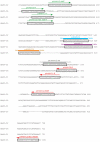Evaluation of type-specific real-time PCR assays using the LightCycler and J.B.A.I.D.S. for detection of adenoviruses in species HAdV-C
- PMID: 22046386
- PMCID: PMC3203158
- DOI: 10.1371/journal.pone.0026862
Evaluation of type-specific real-time PCR assays using the LightCycler and J.B.A.I.D.S. for detection of adenoviruses in species HAdV-C
Abstract
Sporadically, HAdVs from species HAdV-C are detected in acute respiratory disease outbreaks. To rapidly type these viruses, we designed real-time PCR assays that detect and discriminate between adenovirus types HAdV-C1, -C2, -C5, and -C6. Sixteen clinical isolates from the California Department of Public Health were used to validate the new assays. Type-specific TaqMan real-time PCR assays were designed and used independently to successfully identify 16 representative specimens. The lower limit of detection for our LightCycler singleplex real-time PCR assays were calculated to be 100, 100, 100, and 50 genomic copies per reaction for HAdV-C1, HAdV-C2, HAdV-C5 and HAdV-C6, respectively. The results for the singleplex J.B.A.I.D.S. assays were similar. Our assays did not cross-react with other adenoviruses outside of species HAdV-C, respiratory syncytial virus, influenza, or respiratory disease causing bacteria. These assays have the potential to be useful as diagnostic tools for species HAdV-C infection.
Conflict of interest statement
Figures


References
Publication types
MeSH terms
Associated data
- Actions
LinkOut - more resources
Full Text Sources
Molecular Biology Databases
Miscellaneous

